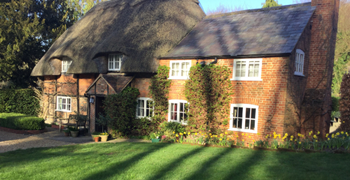31/05/2021
Chimney spark arrestor: Do I need one for my thatched property?
There are various ways to ensure the safe and efficient operation of an open fire or wood-burning stove. Regular maintenance and inspections of both fire and flue, sweeping, a correct chimney height of 1.8m, good quality flue liners appropriate for the house and fire type, stovepipe thermometers and seasoned wood are all key. But, what about chimney spark arrestors?
Chimney spark arrestors are a controversial subject, particularly in the thatched property world. This was not always the case. At one time, most insurers insisted on spark arrestors for thatched properties. However many now warn against them in the belief they can contribute to – rather than avoid – fires or other issues.
So, what are they, their pros and cons and, more importantly, are spark arrestors necessary?
What is a chimney spark arrestor?
A chimney spark arrestor typically consists of a durable metal (steel or aluminium) cowl with a double layer of mesh on the sides. The mesh is what distinguishes them from regular caps or bird/rain protectors. They are either round or square so they can be affixed to the top of a chimney pot or flue.
Its purpose is to catch flammable debris, embers or sparks coming up the flue from open fireplaces or wood-burning stoves. This theoretically prevents the ejected sparks from landing on the roof, nearby trees or flammable materials on the ground, potentially setting them alight. However, the combustion gases can still flow freely through the mesh and escape.
Read more: I Love My Thatched Property
Pros of spark arrestors for thatched properties
On paper, spark arrestors are undoubtedly a good idea and could reduce the risk to thatched property owners by catching embers. However, they can only do this if they are spotlessly clean and in optimum working order.
And although they are not specifically bird guards, they will help keep general debris, rain/weather and birds out of the flue, preventing them from building nests, which is very dangerous.
Cons of spark arrestors for thatched properties
Spark arrestors can get blocked as a result of poor maintenance, natural ageing and wear and tear. Creosote and soot can build up on the spark arrestor, as in the flue. The build-up itself can then, theoretically, combust.
However, unlike a flue, a spark arrestor is usually hard to clean due to its location on the roof. This is the major drawback and the fact that many people believe them to be unsafe.
Some insurers say that spark arrestors must be cleaned each time the flue is swept but that’s often impractical. They need to be taken off and cleaned and few chimney sweeps are willing (or able) to do this in the course of a regular inspection and sweep.
In addition, some sources claim that spark arrestors can raise the risk of fire, by causing sparks or high-energy embers to remain close to the thatch.
Are spark arrestors necessary?
Some (but not all) people believe that sparks and embers are the main cause of thatch fires, favouring the installation of spark arrestors for thatched properties [1]. It seems that these need to be kept exceptionally clean to work, else they themselves pose a fire risk.
In legal terms, there is no fixed answer. You should check with your insurer before either installing or removing a spark arrestor, as it may vary from company to company.
An appropriate professional body such as HETAS may be able to give further advice.
More articles about thatched properties
[1] https://www.nidirect.gov.uk/articles/fire-safety-thatched-buildings
Related Articles





